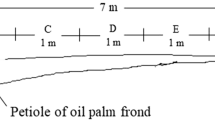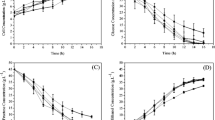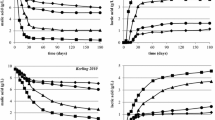Abstract
In the present study, a potential newly isolated thermotolerant acetic acid bacteria (TH-AAB), Acetobacter pasteurianus FPB2-3, with ethanol and acetic acid-tolerant properties was found to be very effective in the production of vinegar from pineapple peels as an alternative, inexpensive raw material using simultaneous vinegar fermentation (SVF). The results showed that using whole pineapple peel with the addition of diammonium phosphate (DAP) and MgSO4 at an initial pH of 5.5 gave a slightly higher acetic acid content than that produced from the squeezed juice. Subsequently, the effects of sugar concentration and inoculation time of A. pasteurianus FPB2-3 on acetic acid production were examined. The results revealed that an increase in sucrose concentration led to the high production of ethanol, which resulted in the suppression of acetic acid production. Allowing for the inoculated yeast to ferment prior to inoculation of the AAB for 1 or 2 days resulted in a longer lag time for ethanol oxidation. However, acetic acid accumulation commenced after 5 days and gradually increased to the maximum concentration of 7.2% (w/v) within 16 days. Furthermore, scaled-up fermentation in 6 l vessels resulted in slower acetic acid accumulation but still achieved a maximum acetic acid concentration of up to 6.5% (w/v) after 25 days. Furthermore, the antioxidant capacity of the vinegar produced from pineapple peels (PPV) was slightly higher than that produced from the squeezed juice (PJV), which was consistent with the higher total phenolic compound content found in the PPV sample. In addition to acetic acid, a main volatile acid present in vinegars, other volatile compounds, such as alcohols (isobutyl alcohol, isoamyl alcohol, and 2-phenyl ethanol), acids (3-methyl-butanoic acid), and esters (ethyl acetate, 3-methyl butanol acetate, and 2-phenylethyl acetate), were also detected and might have contributed to the observed differences in the odour and aroma of the pineapple vinegars.





Similar content being viewed by others
References
Adachi O, Tayama K, Shinagawa E, Matsushita K, Ameyama M (1980) Purification and characterization of membrane-bound aldehyde dehydrogenase from Gluconobacter suboxydans. Agric Biol Chem 44:503–515
Baena-Ruano S, Santos-Dueñas IM, Mauricio JC, Garcia-Garcia I (2010) Relationship between changes in the total concentration of acetic acid bacteria and major volatile compounds during the acetic acid fermentation of white wine. J Sci Food Agric 90(15):2675–2681
Boffo EF, Tavares LA, Ferreira MMC, Ferreira AG (2009) Classification of Brazilian vinegars according to their 1H NMR spectra by pattern recognition analysis. LWT Food Sci Technol 42(9):1455–1460
Budak NH, Aykin E, Seydim AC, Greene AK, Guzel-Seydim ZB (2014) Functional properties of vinegar. J Food Sci 79(5):757–764
Cabrera HAP, Menezes HC, Oliveira JV, Batista RFS (2000) Evaluation of residual levels of benomyl, methyl parathion, diuron, and vamidothion in pineapple pulp and bagasse (smooth cayenne). J Agric Food Chem 48:5750–5753
Callejón RM, Torija MJ, Mas A, Morales ML, Troncoso AM (2010) Changes of volatile compounds in wine vinegars during their elaboration in barrels made from different woods. Food Chem 113(4):1252–1259
Cejudo-Bastante MJ, Durán-Guerrero E, Natera-Marín R, Castro-Mejías R, García-Barroso C (2013) Characterisation of commercial aromatised vinegars: phenolic compounds, volatile composition and antioxidant activity. J Sci Food Agric 93(6):1284–1302
Chandra S, De Mejia EG (2004) Polyphenolic compounds, antioxidant capacity, and quinone reductase activity of an aqueous extract of Ardisia compressa in comparison to mate (llex paraguariensis) and green (Camellia sinensis) teas. J Agric Food Chem 52(11):3583–3589
Chen Y, Bai Y, Li D, Wang C, Xu N, Hu Y (2016) Screening and characterization of ethanol-tolerant and thermotolerant acetic acid bacteria from Chinese vinegar Pei. World J Microbiol Biotechnol 32(1):1–9
Chinnawirotpisan P, Theeragool G, Limtong S, Toyama H, Adachi O, Matsushita K (2003) Quinoprotein alcohol dehydrogenase is involved in catabolic acetate production, while NAD dependent alcohol dehydrogenase in ethanol assimilation in Acetobacter pasteurianus SKU1108. J Biosci Bioeng 96:564–571
Chou CH, Liu CW, Yang DJ, Wu YHS, Chen YC (2015) Amino acid, mineral, and polyphenolic profiles of black vinegar, and its lipid lowering and antioxidant effects in vivo. Food Chem 168:63–69
Claro FB, Rijsbrack K, Soarese V (2007) Flocculation onset in Saccharomyces cerevisiae: effect of ethanol heat and osmotic stress. J Appl Microbial 102:693–700
De Leonardis A, Macciola V, Iorizzo M, Lombardi SJ, Lopez F, Marconi E (2018) Effective assay for olive vinegar production from olive oil mill wastewaters. Food Chem 240:437–440
Del Signore A (2001) Chemometric analysis and volatile compounds of traditional balsamic vinegars from Modena. J Food Eng 50(2):77–90
Drysdale GS, Fleet GH (1989) The effect of acetic acid bacteria upon the growth and metabolism of yeasts during the fermentation of grape juice. J Appl Bacteriol 67:471–481
Elijah AI, Etukudo MP (2016) Quality evaluation of vinegar produced from banana peel using Saccharomyces cerevisiae and Acetobacter aceti isolated from Palm Wine Dreg. Niger J Agric Food Environ 12:205–211
Ghosh PR, Fawcett D, Sharma SB, Poinern GEJ (2016) Progress towards sustainable utilisation and management of food wastes in the global economy. Int J Food Sci. 2016:3563478
Giudici P, Gullo M, Solieri L (2009) Traditional balsamic vinegar. Vinegars of the World. Springer, Milan, pp 157–177
Gullo M, Giudici P (2008) Acetic acid bacteria in traditional balsamic vinegar: phenotypic traits relevant for starter cultures selection. Int J Food Microbiol 125:46–53
Gullo M, Caggia C, Devero L, Giudici P (2005) Characterization of acetic acid bacteria in traditional balsamic vinegar. Int J Food Microbiol 106:209–212
Gullo M, De Vero L, Giudici P (2009) Succession of selected strains of Acetobacter pasteurianus and other acetic acid bacteria in traditional balsamic vinegar. Appl Environ Microbiol 75:2585–2589
Ho CW, Lazim AM, Fazry S, Zaki UKHH, Lim SJ (2017) Varieties, production, composition and health benefits of vinegars: A review. Food Chem. 221:1631
Horiuchi JI, Kanno T, Kobayashi M (1999) New vinegar production from onions. J Biosci Bioeng 88:107–109
Jasmine Praveena R, Estherlydia D (2014) Comparative study of phytochemical screening and antioxidant capacities of vinegar made from peel and fruit of pineapple (Ananas comosus L). Int J Pharma Bio Sci 5:B394–B403
Kanchanarach W, Theeragool G, Yakushi T, Toyama H, Adachi O, Matsushita K (2010) Characterization of thermotolerant Acetobacter pasteurianus strains and their quinoprotein alcohol dehydrogenases. Appl Microbiol Biotechnol 85:741–751
Kantachote D, Charernjiratrakul W, Aussawariangpipop N (2005) Characteristics of fermented plant beverages in Southern Thailand. Songklanakarin J Sci Technol 27:601–615
Ketnawa S, Chaiwut P, Rawdkuen S (2012) Pineapple wastes: a potential source for bromelain extraction. Food Bioprod Process 90:385–391
Kim DO, Lee KW, Lee HJ, Lee CY (2002) Vitamin C equivalent antioxidant capacity (VCEAC) of phenolic phytochemicals. J Agric Food Chem 50(13):3713–3717
Krusong W, Tantratian S (2014) Acetification of rice wine by Acetobacter aceti using loofa sponge in a low-cost reciprocating shaker. J Appl Microbiol 117:1348–1357
Krusong W, Vichitraka A (2010) An investigation of simultaneous pineapple vinegar fermentation interaction between acetic acid bacteria and yeast Warawut. Asian J Food Agro-Industry 3:192–203
Krusong W, Pornpukdeewatana S, Kerdpiboon S, Tantratian S (2014) Prediction of influence of stepwise increment of initial acetic acid concentration in charging medium on acetification rate of semi-continuous process by artificial neural network. LWT- Food Sci Technol 56:383–389
Krusong W, Kerdpiboon S, Jindaprasert A, Yaiyen S, Pornpukdeewatana S, Tantratian S (2015a) Influence of calcium chloride in the high temperature acetification by strain Acetobacter aceti WK for vinegar. J Appl Microbiol 119:1291–1300
Krusong W, Yaiyen S, Pornpukdeewatana S (2015b) Impact of high initial concentrations of acetic acid and ethanol on acetification rate in an internal Venturi injector bioreactor. J Appl Microbiol 118:629–640
Laranjinha JAN, Almeida LM, Madeira VMC (1994) Reactivity of dietary phenolic acids with peroxyl radicals: antioxidant activity upon low density lipoprotein peroxidation. Biochem Pharmacol 48:487–494
Lee JH, Cho HD, Jeong JH, Lee MK, Jeong YK, Shim KH, Il Seo K (2013) New vinegar produced by tomato suppresses adipocyte differentiation and fat accumulation in 3T3-L1 cells and obese rat model. Food Chem 141:3241–3249
Li T, Shen P, Liu W, Liu C, Liang R, Yan N, Chen J (2014) Major polyphenolics in pineapple peels and their antioxidant interactions. Int J Food Prop 17(8):1805–1817
Maestre O, Santos-Dueñas IM, Peinado R, Jiménez-Ot C, García-García I, Mauricio JC (2008) Changes in amino acid composition during wine vinegar production in a fully automatic pilot acetator. Process Biochem 43(8):803–807
Matsushita K, Toyama H, Adachi O (1994) Respiratory chains and bioenergetics of acetic acid bacteria. Adv Microb Physiol 36:247–301
Ndoye B, Lebeccque S, Dubois-Dauphin R, Tounkanra L, Guiro AT, Kere C, Diawara B, Thonart P (2006) Thermoresistant properties of acetic acids bacteria isolated from tropical products of Sub-Saharan Africa and destined to industrial vinegar. Enz Microb Technol 39:916–923
Ohmori S, Masai H, Arima K, Beppu T (1980) Isolation and identification of acetic acid bacteria for submerged acetic acid fermentation at high temperature. Agric Biol Chem 44:2901–2906
Othaman MA, Sharifudin SA, Mansor A, Kahar AA, Long K (2014) Coconut water vinegar: new alternative with improved processing technique. J Eng Sci Technol 9(3):293–302
Ozturk I, Caliskan O, Tornuk F, Ozcan N, Yalcin H, Baslar M, Sagdic O (2015) Antioxidant, antimicrobial, mineral, volatile, physicochemical and microbiological characteristics of traditional home-made Turkish vinegars. LWT Food Sci Technol 63(1):144–151
Peñalvo JL, Haajanen KM, Botting N (2005) Quantification of lignans in food using isotope dilution gas chromatography/mass spectrometry. J Agric Food Chem 53:9342–9347
Perumpuli PABN, Watanabe T, Toyama H (2014) Identification and characterization of thermotolerant acetic acid bacteria strains isolated from coconut water vinegar in Sri Lanka. Biosci Biotechnol Biochem 78:533–541
Roda A, Lucini L, Torchio F, Dordoni R, De Faveri DM, Lambri M (2017) Metabolite profiling and volatiles of pineapple wine and vinegar obtained from pineapple waste. Food Chem 229:734–742
Saichana N, Matsushita K, Adachi O, Frébort I, Frebortova J (2015) Acetic acid bacteria: a group of bacteria with versatile biotechnological applications. Biotechnol Adv 33:1260–1271
Sainz F, Navarro D, Mateo E, Torija MJ, Mas A (2016) Comparison of D-gluconic acid production in selected strains of acetic acid bacteria. Int J Food Microbiol 222:40–47
Salbe AD, Johnston CS, Buyukbese MA, Tsitouras PD, Harman SM (2009) Vinegar lacks antiglycemic action on enteral carbohydrate absorption in human subjects. Nutr Res 29:846–849
Shahidi F, McDonald J, Chandrasekara A, Zhong Y (2008) Phytochemicals of foods, beverages and fruit vinegars: chemistry and health effects. Asia Pac J Clin Nutr 17(1):380–382
Soemphol W, Saichana N, Yakushi T, Adachi O, Matsushita K, Toyama H (2012) Characterization of genes involved in D-sorbitol oxidation in thermotolerant Gluconobacter frateurii. Biosci Biotechnol Biochem 76(8):1497–1505
Solieri L, Giudici P (2008) Yeasts associated to Traditional Balsamic Vinegar: ecological and technological features. Int J Food Microbiol 125:36–45
Sossou SK, Ameyapoh Y, Karou SD, de Souza C (2009) Study of pineapple peelings processing into vinegar by biotechnology. Pak J Biol Sci 12:859–865
Su MS, Chien PJ (2010) Aroma impact components of rabbiteye blueberry (Vaccinium ashei) vinegars. Food Chem 119(3):923–928
Ubeda C, Callejón RM, Troncoso AM, Moreno-Rojas JM, Peña F, Morales ML (2012) Characterization of odour active compounds in strawberry vinegars. Flavour Fragr J 27(4):313–321
Ubeda C, Callejón RM, Hidalgo C, Torija MJ, Troncoso AM, Morales ML (2013) Employment of different processes for the production of strawberry vinegars: effects on antioxidant activity, total phenols and monomeric anthocyanins. LWT Food Sci Technol 52:139–145
Valli M, Sauer M, Branduardi P, Borth N, Porrot D, Mattanovich D (2005) Intracellular pH distribution in Saccharomyces cerevisiae cell populations, analyzed by flow cytometry. Appl Environ Microbiol 71:1515–1521
Wang Z, Yan M, Chen X, Li DS, Qin L, Li Z, Yao J, Liang X (2013) Mixed culture of Saccharomyces cerevisiae, and Acetobacter pasteurianus, for acetic acid production. Biochem Eng J 79(2):41–45
Xia K, Zang N, Zhang J, Zhang H, Li Y, Liu Y, Liang X (2016) New insights into the mechanisms of acetic acid resistance in Acetobacter pasteurianus using iTRAQ-dependent quantitative proteomic analysis. Int J Food Microbiol 238:241–251
Ye XJ, Morimura S, Han LS, Shigematsu T, Kida K (2004) In vitro evaluation of physiological activity of vinegar produced from barley-, sweet potato-, and rice-shochu post-distillation slurry. Biosci Biotechnol Biochem 68:551–556
Zheng Y, Zhang R, Yin H, Bai X, Chang Y, Xia M, Wang M (2017) Acetobacter pasteurianus metabolic change induced by initial acetic acid to adapt to acetic acid fermentation conditions. Appl Microbiol Biotechnol 101(18):7007–7016
Acknowledgements
This work was financial supported by National Research Council of Thailand (NRCT), allocated by Khon Kaen University (No. 590029).
Author information
Authors and Affiliations
Contributions
VT carried out the experiments, analysed the data and participated in drafting the manuscript. MC participated in the data analysis of the pineapple vinegar. WS contributed to the design of the experiments, conducted the experiments, analysed the data, participated in drafting the manuscript and revised the manuscript. All authors read and approved the final manuscript.
Corresponding author
Ethics declarations
Conflict of interests
The authors declare no conflict of interests.
Rights and permissions
About this article
Cite this article
Tanamool, V., Chantarangsee, M. & Soemphol, W. Simultaneous vinegar fermentation from a pineapple by-product using the co-inoculation of yeast and thermotolerant acetic acid bacteria and their physiochemical properties. 3 Biotech 10, 115 (2020). https://doi.org/10.1007/s13205-020-2119-4
Received:
Accepted:
Published:
DOI: https://doi.org/10.1007/s13205-020-2119-4




